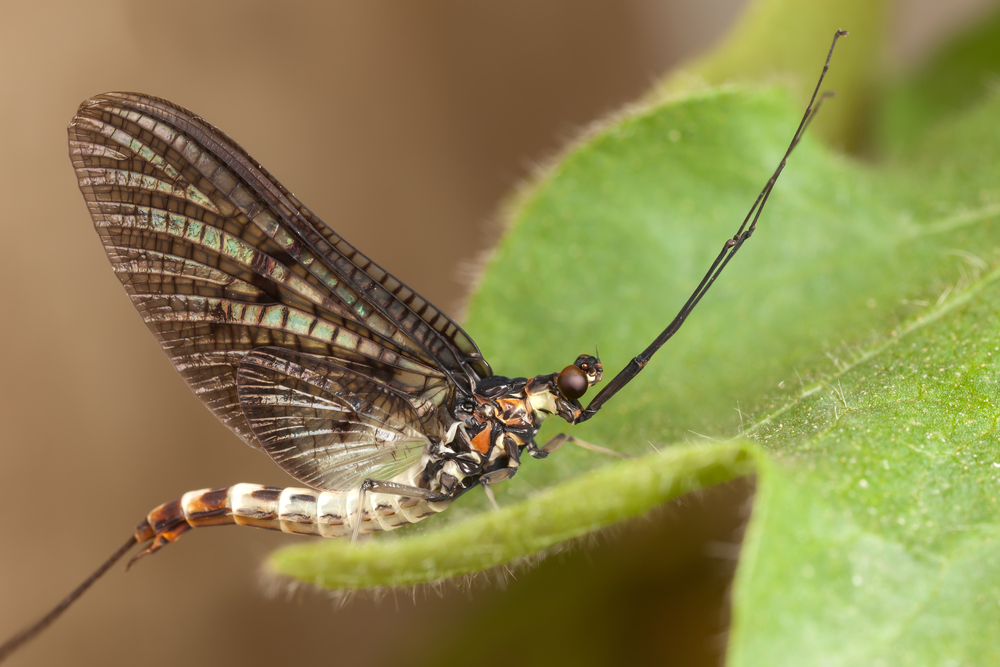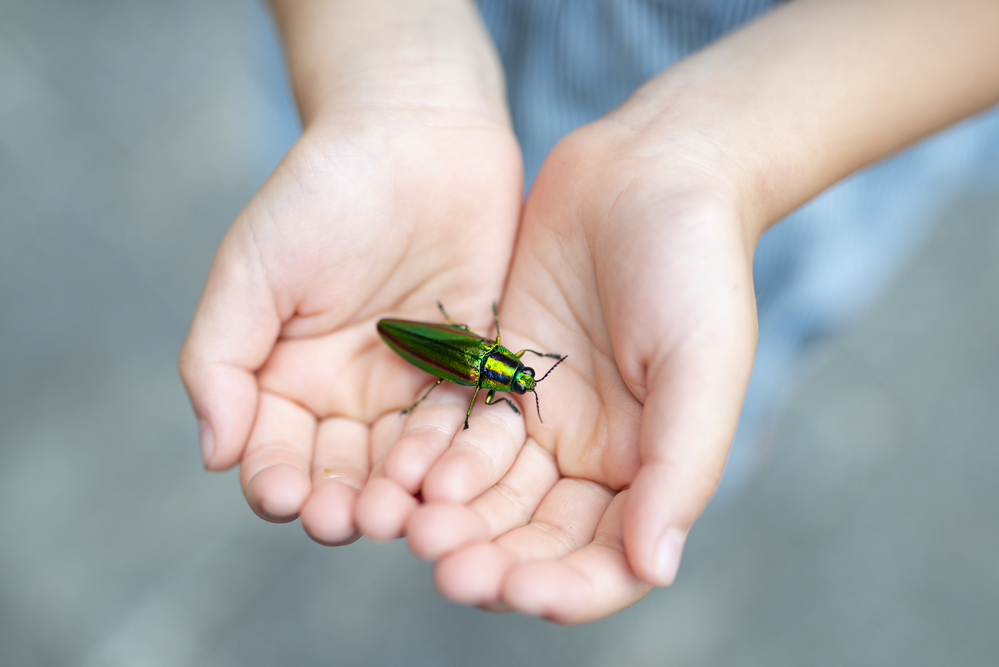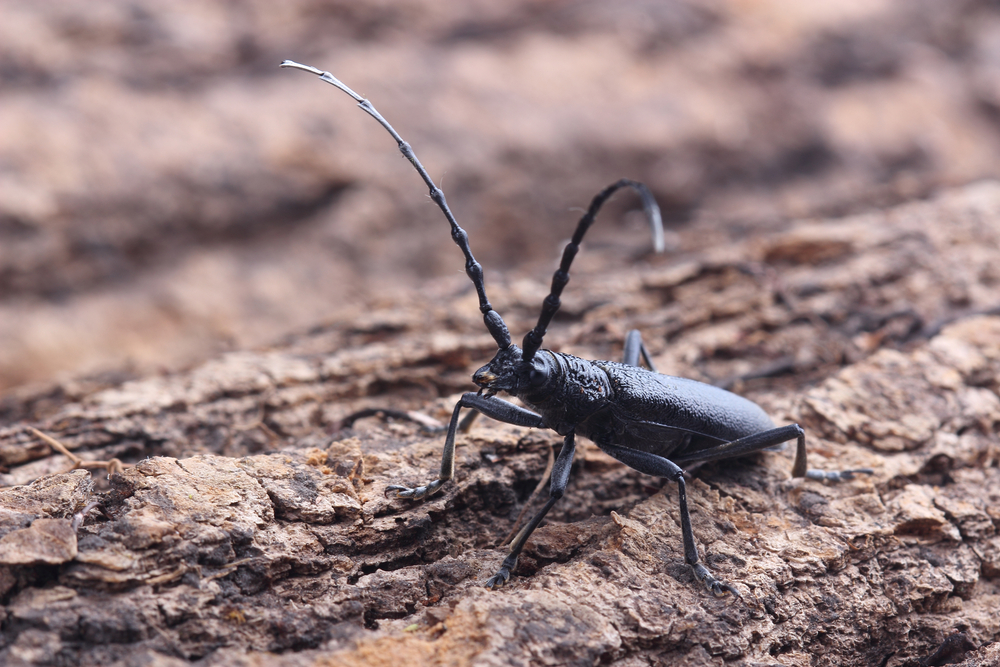The World’s 25 Largest Insects Are a Mix of Fascination and Fear

Imagine a dragonfly with a wingspan as wide as a hawk’s – that was the Meganeuropsis, the largest insect that ever existed but is now extinct. An inhabitant of the Paleozoic era, this giant reigned about 300 million years ago. Today, while we may not see such enormous creatures in our backyard, a myriad of giant bugs continue to inhabit the Earth. So, if you’re intrigued by the insect world’s beasts of burden, brace yourself for an interesting discovery of the world’s largest living bugs.
Mayfly

Native to lakes, rivers, and wetlands worldwide, Mayflies are aquatic insects noted for their short yet significant existence. They primarily serve as a vital food source to surrounding carnivorous species. Their unique life cycle contributes significantly to their respective ecosystems, while their size, reaching up to 1 inch, often leaves spectators in awe.
Japanese Giant Hornet

There’s something unsettling about the Japanese Giant Hornet. Word of its venomous sting spreads fear far wide. As if its reputation isn’t hard-hitting enough, the physical attributes solidify its stance. This hornet is a giant in its kind, having the potential to grow up to a whopping 2 inches in length. Truly a formidable titan of the insect world.
Tarantula Hawk

The Tarantula Hawk, a distinctive wasp species from the Pepsis genus, earns its name from its hunting technique. It seeks out and incapacitates tarantulas as food for its larvae. With a stunning metallic blue body and rust-colored wings, this wasp can reach significant lengths, around 2 inches, making it one of the largest wasp species in the world.
Giant Burrowing Cockroach

The Giant Burrowing Cockroach, known scientifically as Macropanesthia rhinoceros, holds the title of being the world’s heaviest cockroach. Indigenous to Australia, it can weigh up to 35 grams and reach lengths of about 3 inches. Living in elaborate burrows, it’s an essential part of the ecosystem, aiding in decomposition of fallen leaves and other organic matter.
Cicada

Often mistaken for locusts, cicadas are large insects known for their pronounced and rhythmic calling song. These fascinating creatures spend most of their lives underground, but when they emerge, there are few insects that can match their size, reaching up to 3 inches in length. Ranging extensively in color and species, cicadas are a remarkable sight in the insect kingdom.
Desert Locust

The Desert Locust is a formidable bug indeed. Most known for its insatiable appetite and devastating swarms, this bug lives in Africa, the Middle East, and Asia. They usually grow up to 2.8-3.5 inches, posing an incredible sight when they swarm in their billions, covering vast areas and causing extensive damage to vegetation.
Jewel Beetle

Displaying a stunningly vibrant and iridescent exoskeleton, the Jewel Beetle boasts incredible sizes of up to 3.3 inches long. Originating from the Buprestidae family, these beetles’ dazzling colors and metallic shades make them truly a sight to behold. Intricate patterns on their body distinguish them as one of the world’s most remarkable bugs.
Emperor Dragonfly

The Emperor Dragonfly stands out as one of nature’s finest artisans, renowned for its iridescent coloration and swift flight. As a resident of Northern Europe, this bug can reach a wingspan up to 4.1 inches, making it one of the largest dragonflies globally.
Giant Weta

The Giant Weta, a nocturnal inhabitant of New Zealand, holds the record as the heaviest insect in the world according to Guinness, with a verified weight reaching up to 2.5 ounces. Despite its impressive size, this insect is vulnerable to predators such as cats and rats, which makes conservation efforts crucial for its survival.
Goliath Beetle

The Goliath Beetle, scientifically known as Goliathus goliatus, is renowned for its extraordinary size and weight. These bugs are some of the largest insects on earth, with measurements that can reach up to 4.3 inches in length. Remarkably, during their larval stage, they can weigh over 3.5 ounces, making them amongst the heaviest insects too.
Giant Water Bug

Known to be one of the largest aquatic insects globally, the Giant Water Bug, found spanning the lands of North and South America, can achieve a staggering length of 4 inches. These predators, possessing robust front legs, deploy them skillfully for seizing prey.
Actaeon Beetle

Found in the dense, tropical rainforest of the Amazon, the Megasoma Actaeon, or the Actaeon Beetle, is a remarkable specimen of the rhinoceros beetles. These predominantly night wandering creatures surprise many with their formidable size, reaching up to 4.7 inches in length.
Atlas Beetle

Belonging to the scarab beetle family, the Atlas Beetle is a remarkable specimen known for its impressive size and strength. This beetle resides primarily in Southern Asia, specifically in Indonesia. Its unique physical characteristics, such as its heavy-set body and oversized horns, can reach lengths of 5 inches. Its intense strength enables it to lift up to 850 times its body weight.
Titan Beetle

Native to the lush Amazon rainforest, the Titan Beetle has an impressive claim to fame. This astounding insect is renowned for its substantial size, measuring up to 6.6 inches in length. It’s particularly noteworthy for its larvae which are estimated to grow to be approximately 2 inches wide and a staggering 1 foot long.
Giant Katydid

The Giant Katydid, known scientifically as Macrolyristes corporalis, is an impressive specimen. This colossal creature can grow up to 6 inches in length, making it one of the largest katydids in the world. Native to the rainforests of Malaysia, their incredibly long legs and antennae contribute to their monumental size.
Praying Mantis

The Praying Mantis is known for its distinctive posture, resembling a prayer stance, which it uses while waiting for prey. Its elongated body can grow up to 6 inches in length. Although found in various colors, the bright green variant is most recognized. Despite their serene appearance, they are voracious predators and can turn their heads a full 180 degrees to spot potential prey.
Longhorn Beetle

Renowned for its impressive antennae, the Longhorn Beetle makes its mark in the world of large insects. Found globally, these beetles showcase unique patterns and colors. Remarkably, their lifespan ranges from two to four years, a decent age for an invertebrate. Their size varies, but certain species can grow up to 6.7 inches in length.
Hercules Beetle

Native to the rainforests of Central and South America, the Hercules Beetle is a species of rhinoceros beetle. Males of this species flaunt sizable horns that can make up half its body length of 6.7 inches. They find their sustenance in fruit and sap. Taking the horn into account, the Hercules Beetle can reach lengths of up to 7 inches, becoming a true titan of the insect world.
Scorpion

As nocturnal hnters, scorpions are a cause for caution. Their size varies significantly, from the little 0.5-inch long Typhlochactas mitchelli, up to the formidable 8.3-inch long Heterometrus swammerdami. Armed with a tail ended with venomous stinger, scorpions use it both for defense and to immobilize their prey. Don’t worry though, most species aren’t dangerous to humans!
Atlas Moth

The Atlas Moth is a remarkable creature known for its size and longevity. Native to Southeast Asia, it’s hailed as the largest moth boasting an expansive wingspan of approximately 10 inches. A unique characteristic of this moth is the absence of a mouth, restricting its adult life to a brief existence of mere days.
Tarantula

Tarantulas, famously known for their intimidating size and hairy appearance, are among the world’s largest spiders. Though they may appear daunting, they are often harmless and prefer to retreat rather than bite. Some species boast leg spans that can reach up to 10 inches, truly living up to the ‘giant’ moniker.
Queen Alexandra’s Birdwing Butterfly

The Queen Alexandra’s Birdwing Butterfly, named after Queen Alexandra of England, is recognized as the world’s largest butterfly. Primarily found in Papua New Guinea, the species boasts a remarkable wingspan reaching a staggering 11 inches. However, due to significant habitat destruction and the ongoing threat from collectors, this majestic insect is listed as endangered by the IUCN.
Giant Centipede

The Giant Centipede, a creature not for the faint-hearted, pushes size boundaries in the insect world. Growing up to an astonishing 12 inches, it’s among the most substantial critters to crawl the earth. Threatening in presence, their role is unique and pivotal in maintaining balance in their habitats.
Giant African Millipede

On your list of gigantic bugs, you can’t afford to skip the Giant African Millipede. Widely recognized for being the world’s largest species of millipede, it frequently reaches lengths of up to 1 feed. Despite their somewhat intimidating size, these creatures are harmless leaf eaters and are popular pets in some places. Their nickname, “shongololos,” is as fun to say as they’re interesting to observe.
Giant Stick Bug

Defying all size stereotypes, the Giant Stick Bug stands as the world’s longest insect, often surpassing 22 inches in length, legs included. Its elongated figure assists in camouflaging itself among branches and twigs in its natural habitat. Though colossal in size, it possesses a gentle demeanor, making it a fascinating specimen to bug lovers worldwide.
About the Author

Meet Jacqueline, a seasoned writer at Animaloverse who has spent over a decade exploring the fascinating world of animals. Her love for animals, which also fuels her writing, is drawn from her personal experiences with all kinds of pets. The animal kingdom continues to ignite her curiosity as she discovers new insights every day. She also finds joy and personal growth through sports. In winter, she enjoys skiing, embracing the thrill of invigorating cold weather activities. When summer arrives, she sets out on hiking trails, exploring the beauty of nature. Among all her passions, her dog Bailey holds a special place in her heart as together, they go on exciting adventures. The happiness she experiences with Bailey often serves as inspiration for her writing.






